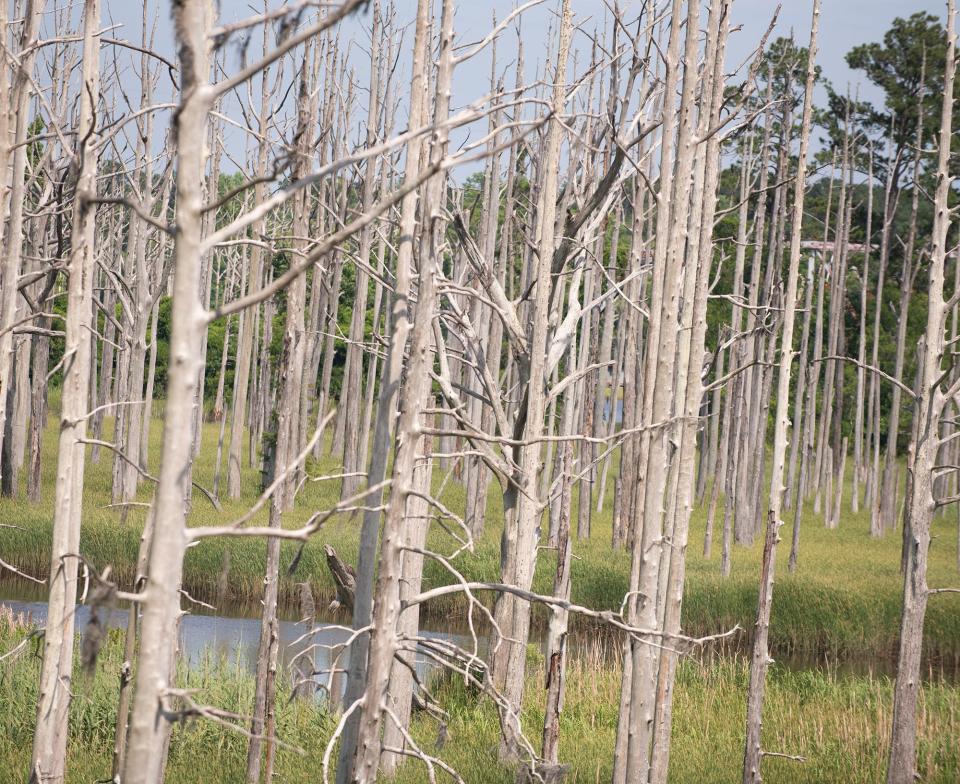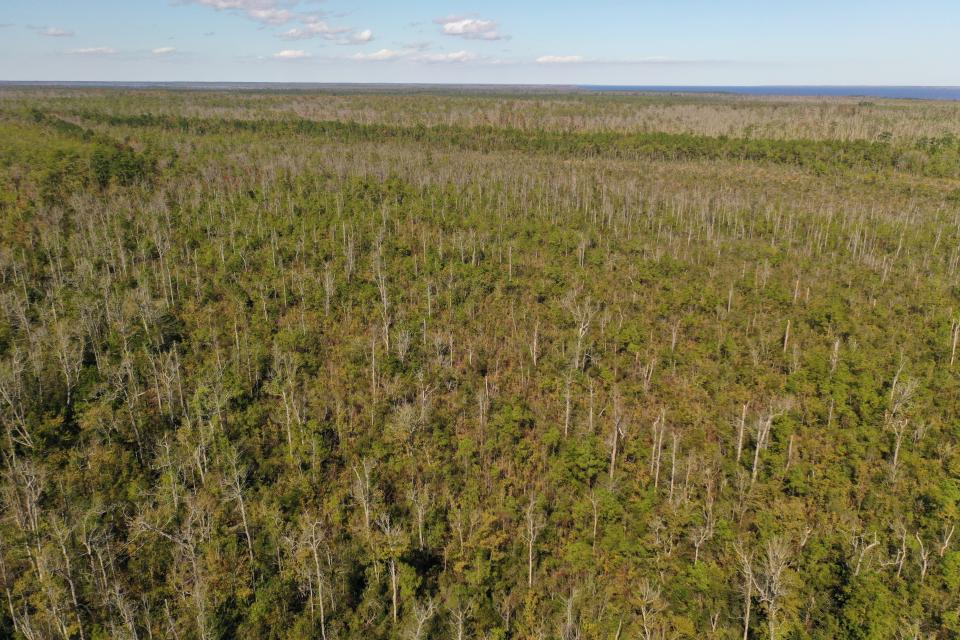Are NC's 'ghost forests' a canary in the coal mine for upcoming coastal change?
They are the tall, grayish-white, often limbless sentinels that rise from the marshes as the mainland ends and North Carolina's extensive coastal rivers, estuaries and sounds begin.
They are ghost forests, and clusters, sometimes hundreds of these dead and dying trees can be found lining the Cape Fear River and many of the Wilmington area's tidal creeks and brackish channels. From Smith Creek near the Wilmington International Airport to Town Creek in Brunswick County and countless other local waterways, the carcasses of dying trees stick up from the marsh. Along shorelines, a graveyard of stumps is often visible.
These forests of tree skeletons can be found all along the coasts of North Carolina, South Carolina, Georgia and the Chesapeake Bay tracking north, and their ranks are growing as climate change combines with man's engineering of the coast to allow salt water to seep farther and farther inland.

What are ghost forests?
They represent areas where the marsh and vegetation hasn't been able to keep up with an increased exposure to salinity. The salty water slowly poisons the trees, leaving them as graying pillars of environmental change before they eventually collapse.
While some trees like cypress and some cedars can survive in brackish waters, too much salt can cause widespread tree death.
The increase in salt water impacts other vegetation, with grasses and other plants replaced with more salt-tolerant species before they are often also wiped out by the rising salinity.
Why are ghost forests increasing?
While some habitat transformation would be expected under natural conditions, man's decades of pumping millions of tons of heat-trapping greenhouse gases into the atmosphere has changed the world's weather patterns.
The warming planet has increased the melting of the ice caps, raising sea levels and allowing salt water to reach farther inland and in greater quantities. Rising ocean temperatures also are contributing to the problem, since the volume of the ocean is expanding as the sea water warms.
In short, the change in ecosystems is now happening much faster than before.
WOODEN WARRIORS Ancient NC trees have survived thousands of years. Will they weather climate change?
Climate change means stronger and bigger tropical weather systems, where amplified storm surge pushes water father onto land and up waterways. Increasing and more persistent periods of drought, another sign of climate change, also means there's sometimes less freshwater to counter the impacts of the salt water pulses. North Carolina has experienced several periods of extended drought in recent years.
A 2021 research paper published by scientists from Duke University used historical pictures from Google Earth to determine that nearly one-third of the Alligator River National Wildlife Refuge, famous for being the only wild home of the highly endangered red wolf, had transformed from forest habitat to shrub land or marsh over the past 35 years. Another roughly 11% of the protected area in northeastern North Carolina had become a ghost forest.
Researchers at the Virginia Institute of Marine Science measuring coastal forest retreat rates using historical maps and core samples have seen it jump from less than 0.5 meters (1.6 feet) per year in parts of North Carolina prior to 1875 to more than 4 meters (13 feet) in places today. They also noted that land submergence in a coastal area that runs from North Carolina to Massachusetts is contributing to the growth of ghost forests, with sea-level rates rising three times faster than global rates.

Are ghost forests as environmentally valuable as other coastal forests?
Ghost forests don't provide the range of habitat for freshwater and saltwater flora and fauna that a healthy coastal forest and brackish environment does. Researchers are still trying to determine the long-term impacts from these changes to coastal systems on migrating birds, insects, invertebrates, and other critters and plants that call them home.
Ghost forests also can't provide the protection that a healthy forest does by helping absorb the wind and water energy from hurricanes and other strong weather events. That's because as the trees die and other organic material in the wetlands succumbs to the increased salinity in the water, the marshes start falling apart and washing away.
The wetlands also are great carbon sinks, but that capability is lost as they are washed away. A 2021 study by N.C. State researchers found that ghost trees, colloquially called snags, increased greenhouse gas emissions of the overall decomposing wetland ecosystem by about 25%.
MORE North Carolina's wetlands emit lots of climate-warming methane gas. Is that bad?
The result of the transitioning wetlands are wide savannahs of open saltwater marsh − and eventually open water − dotted with dead and dying trees. And while sometimes freshwater habitats can retreat inland and attempt to rebuild, topography and the sheer speed at which sea-level rise is impacting saltwater intrusion makes this a tough proposition.
In the Wilmington area, a sign of this transformation is clearly visible − especially from the Interstate 140 bridge − along the Northeast Cape Fear River north of Wilmington, where the river delta is spreading out as salt water overcomes the former freshwater marsh areas.
What about human actions beyond climate change?
As humans have engineered the coast to meet our needs, the changes are allowing the higher levels of salt water to reach farther inland.
In many parts of coastal North Carolina, large systems of ditches were built to drain and irrigate fields. But that same water infrastructure is now allowing salt water to push well inland from the coast, adding to stress on freshwater habitats miles away from the shoreline and degrading crop productivity.
In Southeastern North Carolina, the deepening of the Cape Fear River shipping channel over the decades has changed much of the habitat along the river and its tributaries as officials work to keep the Port of Wilmington competitive in a globally connected world where size − especially when it comes to ships − does matter.
PUSHING DEEPER As other Southeast ports get deeper, what's the status of Wilmington's expansion project?
When Europeans first eyed the Cape Fear River, it was a shallow estuary that could be crossed on foot. Today, blue crabs and flounder can be caught as far inland as Lock and Dam No. 1 in Bladen County − more than 40 miles inland.
Several environmental groups, including the N.C. Coastal Federation and Cape Fear River Watch, have raised concerns that the latest proposal to deepen the shipping channel, this time from 42 feet to 47 feet, will hasten the transformation of freshwater wetlands in the river estuary, costing habitat and floodwater protection in areas that are already seeing an increased risk of flooding due to sea-level rise and climate change.
So what happens now?
To slow down the transition of the coastal forest ecosystem, officials are trying a variety of steps to mitigate the rising salt waters.
They include installing living shorelines and oyster reefs along shorelines to absorb tidal energy and limit erosion to re-engineering ditches and dikes to prevent salt water from pushing inland. Where possible, some efforts also are being made to plant freshwater marsh vegetation inland to allow it to get established and provide important habitat before the salt water arrives.
But building resiliency into a system that's low-lying and facing a threat that increases every year as sea-level rise gains momentum isn't easy. The United Nation's Intergovernmental Panel on Climate Change (IPCC) has said global sea levels could rise more than 3 feet by the end of the century if additional steps aren't taken to curb the warming of the planet. Estimates by NOAA's National Climate Assessment are even more sobering, stating that the seas could rise by double that amount if the rapid loss of Antarctic ice occurs.
Reporter Gareth McGrath can be reached at GMcGrath@Gannett.com or @GarethMcGrathSN on Twitter. This story was produced with financial support from 1Earth Fund and the Prentice Foundation. The USA TODAY Network maintains full editorial control of the work.
This article originally appeared on Wilmington StarNews: Ghost forests in NC expanding with sea level rise, climate change

